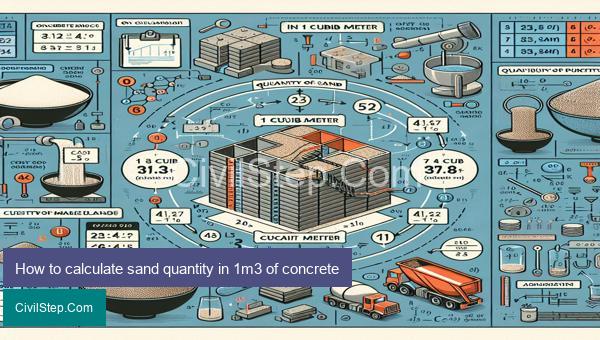
Concrete is one of the most commonly used building materials, known for its versatility, strength, and durability. It is composed of a mixture of cement, water, aggregates, and sometimes additives to achieve desired properties. When it comes to creating concrete, accurately calculating the quantities of each ingredient is crucial for the desired strength and consistency of the final product. In particular, the amount of sand used in concrete plays a significant role in its overall composition. In this article, we will explore all about calculating the sand quantity in 1m3 of concrete, including the importance of sand in concrete, factors affecting the sand quantity, and the step-by-step process of calculating sand quantity in 1m3 of concrete. Whether you are a construction professional or a
How to calculate sand quantity in 1m3 of concrete

Calculating the exact amount of materials needed for a construction project is a crucial aspect of the job of a civil engineer. One essential material used in concrete construction is sand. The quantity of sand needed for a project is usually measured in cubic meters (m3). Therefore, knowing how to calculate the sand quantity in 1m3 of concrete is crucial for any civil engineer.
Here are the steps to follow in calculating sand quantity in 1m3 of concrete:
Step 1: Determine the proportion of sand in the concrete mix
The proportion of sand in the concrete mix refers to the amount of sand used in relation to the total volume of the concrete mix. This ratio is usually specified in the design mix of the concrete project, and it varies depending on the strength and type of concrete needed. For example, a 1:2:4 concrete mix has a proportion of 1 part cement, 2 parts sand, and 4 parts gravel or crushed stone.
Step 2: Calculate the volume of concrete needed
To calculate the volume of concrete needed for the project, you will first need to determine the volume of the entire structure to be constructed. This includes the length, width, and thickness of the structure. Multiply these three dimensions to get the total volume in cubic meters (m3).
Step 3: Calculate the volume of sand
Multiplying the total volume of the concrete by the proportion of sand in the concrete mix gives you the volume of sand needed for the project. For example, if the total volume of concrete needed is 5m3, and the proportion of sand in the mix is 2 parts, the volume of sand needed will be 5m3 x 2/7 (since sand constitutes 2 parts out of 7 parts of the mix) = 1.43m3.
Step 4: Convert the volume of sand to weight
Sand is usually measured and sold by weight, and the density of sand may vary depending on its source. Therefore, it is essential to check the density of the sand to be used and then convert the volume of sand to weight.
Step 5: Calculate the final sand quantity in 1m3 of concrete
To calculate the final amount of sand needed for 1m3 of concrete, multiply the weight of the sand by the proportion of sand in the mix (2/7 in this example). So, if the weight of the sand is 1600kg, the final amount of sand needed for 1m3 of the concrete mix will be 1600kg x 2/7 = 457kg.
In conclusion, calculating the sand quantity in 1m3 of concrete is a simple process that involves determining the proportion of sand in the mix, calculating the volume of concrete needed, and converting the volume of sand to weight. By following these steps, a civil engineer can accurately determine the amount of sand needed for any concrete project.
Conclusion
In conclusion, calculating the sand quantity in 1m3 of concrete is a crucial step in the construction process. It ensures the right amount of sand is used to achieve the desired strength and durability of the concrete. By understanding the factors that affect the sand quantity, such as the type of sand and the water-cement ratio, builders can accurately determine the amount of sand needed for their project. With proper calculations, construction projects can be executed with efficiency and precision, resulting in high-quality concrete structures. It is important for builders to carefully calculate the sand quantity to avoid any unnecessary wastage and to achieve a successful and long-lasting concrete mix. Overall, having a thorough understanding of how to calculate sand quantity in 1m3 of concrete is essential
